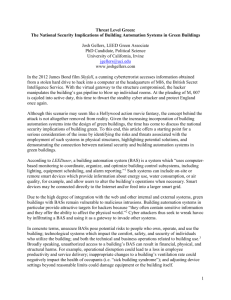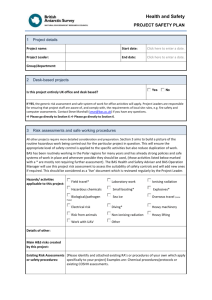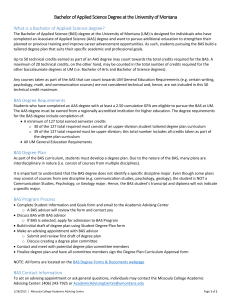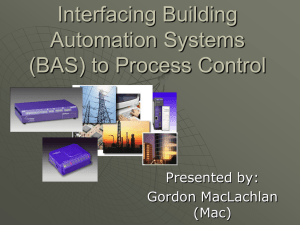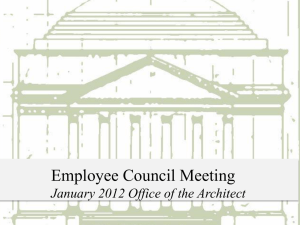***********V
advertisement
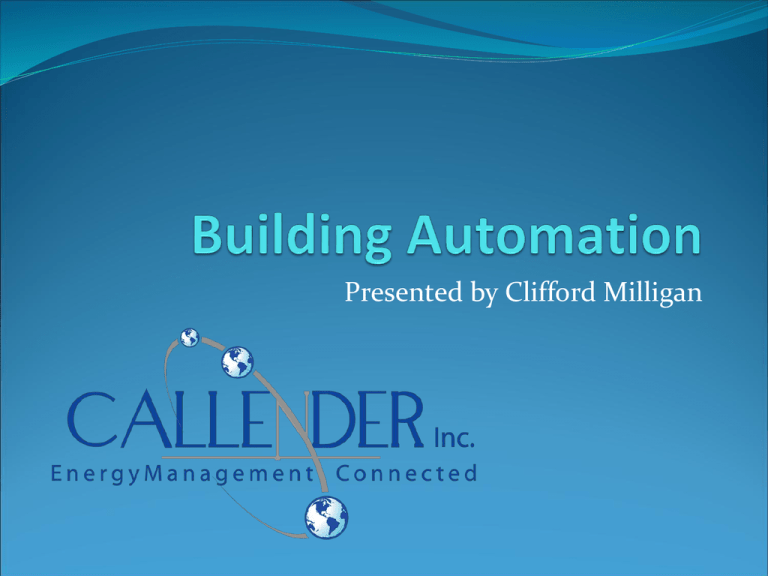
Presented by Clifford Milligan Introduction What is Building Automation? With this presentation, you will have brief understanding of what a BAS system is and how it effects energy efficiency of buildings. I’ve been in the Building Automation business for 12 years. I’ve worked on smaller facilities like a remote building for a refinery to larger facilities like college campuses with many buildings. Topic Outline 1: Intro to BAS and Terminology 2: Components 3: Maximizing energy performance 4: Communications protocol and Interoperability 5: User interface demonstration 1: Intro to BAS What is it? The majority of BAS systems are for HVAC only, even still today. That’s why you probably hear HVAC controls most of the time. With the new energy crisis, we are expanding into controlling or interfacing with all the different systems buildings have. Such as HVAC, lighting, card access, utilities, fire and many others. 1: Wikipedia BAS core functionality keeps the building climate within a specified range, provides lighting based on an occupancy schedule, and monitors system performance and device failures and provides email and/or text notifications to building engineering staff. The BAS functionality reduces building energy and maintenance costs when compared to a non-controlled building. A building controlled by a BAS is often referred to as an intelligent building system. 1: Terminology Building Automation System (BAS) Energy Management System (EMS) Building Management System (BMS) Direct Digital Controls (DDC) All are typical references to Building Automation 1: ASHRAE The American Society of Heating, Refrigerating and Air-Conditioning Engineers To advance the arts and sciences of heating, ventilating, air conditioning and refrigerating to serve humanity and promote a sustainable world 1: California’s Title 24 Enforced by The California Energy Commission Has mandatory efficiency standards for HVAC, Lighting, Roofing and many other components in facilities. This makes automation almost mandatory in most commercial buildings. 1: LEED and Green Buildings Leadership in Energy and Environmental Design LEED certifications are given by the U.S. Green Building Council Facilities get LEED Points for energy efficiency designs and many other green deigns such as water efficiency. Certified 40–49 points Silver 50–59 points Gold 60–79 points Platinum 80 points and above 2: Components 2: Interface Allows access in system to make changes and view history. Most now are accessed through a web browser which allows access all over the world. Sends alarms to email, cell phone, or on a local computer 2: Interface sample 2: PLC or Central Plant Controller Allows access in system to make changes and view history. Most now are accessed through a web browser ,which allows access all over the world. Also can have I/O boards for local control 2: Unitary Controller Contains logic for locally controlled devices Some are programmed with the software in the plant controller and some require a separate tool for programming. 2: End devices Thermistor sensors for space, air and water temperature Co2 Sensors Flow Sensors Humidity Sensors Current sensors Static pressure sensors Water pressure sensors Actuators for valves and dampers 3: Maximizing energy performance Getting the most out of your BAS Minimum Code Requirements Enhanced Strategies BAS Technology Trends Energy Monitoring and Accounting 3: Getting the most out of your BAS Control Devices Monitoring Tools Metering Capability Human Machine Interface (HMI) Interoperability Legacy Systems Support 3:Minimum Code Requirements ASHRAE 90.1 Mandatory Provisions Zone Thermostatic Control Cooling/Heating Setpoint Overlap Restriction & Dead Band Off-Hour Automatic Shutdown and Setback Controls Optimum Start Controls Ventilation System Motorized Shutoff Dampers Humidifier preheat shut off valve for preheat jackets mounted in air stream Demand Control Ventilation (DVC) Ventilation Controls for High Occupancy areas to reduce outdoor air Lighting Controls Automatic Shutoff (interior & exterior) Occupancy-based shutoff 3:Enhanced Strategies Electric Demand Limiting Demand Controlled Ventilation (DCV) with CO2 Monitoring Occupancy based HVAC Setback Terminal Air Distribution ECM Motor Control Daylight Harvesting Natural Ventilation Control VAV Supply Air Temperature Reset Kitchen Hood Fan Speed Control Emergency Egress Lighting Control 3: BAS Technology Trends Control Systems Interoperability BACnet LonWorks XML & Web Services ZigBee Web Based Supervisory Control Wireless Sensor Networking Integration with Fire/Life Safety, Security & Lighting Controls Dashboard HMI Displays Building Information Model (BIM) Intelligent Buildings 3: Energy Monitoring and Accounting Studies have shown that building occupants are more sensitive to resource use when information is available to them regarding how much energy and water they are consuming. A Measurement & Verification (M&V) process will allow the facility manager to discover anomalies in consumption patterns of building utilities associated with inefficient equipment and systems operation. Confirmation of Design Energy Conservation Measures (ECM) LEED Credit All Building Utilities Metering Required May Require Continuous Isolated Metering (Sub-Metering) of: Lighting Loads and Controls Motor Loads Economizer/Heat Recovery Systems Air Distribution Pressures and Airflow Heating/Cooling Loads & Equipment Efficiencies 3: Energy Numbers According to the EPA, energy upgrades typically have a 20 to 30 percent rate of return and are low risk. At a 10 percent capitalization rate, a building owner can generate $2 to $3 in incremental asset value for each $1 invested in energy performance improvements. Saving 30 percent of energy costs is equal to increasing NOI (Net Operating Income) by five percent. Energy Facts: Commercial buildings account for 18% of total energy consumption Energy costs represent 30% of typical building’s annual budget and is the single largest operating cost LEED or Energy Star buildings cost $2-$5 more per sq.ft., but the return investment is an average of $20-$50 per sq.ft. over 20 years. Green Buildings can reduce: Energy Use 24%-50% CO2 Emissions 33%-39% Water Use 40% Solid Waste 70% 4: Communications protocol and Interoperability BACnet LonWorks Modbus OBIX OPC 4: BACnet Developed under the auspices of the American Society of Heating, Refrigerating and Air-Conditioning Engineers (ASHRAE). Building Automation and Control Network. Protocol Rules Addressing Network access (RS-485 or IP) Error Checking Flow Control Message Format 4: LonWorks LonWorks is a networking platform specifically created to address the unique performance, reliability, installation, and maintenance needs of control applications. The platform is built on a protocol created by Echelon Corporation for networking devices over media such as twisted pair, power lines, fiber optics, and RF. Free topology Peer to peer or IP Standard microprocessor and transceiver No address each transceiver has a MAC type address built in 4: Modbus Modbus is a serial communication protocol published by Modicon in 1979 for use with its Programmable Logic Controllers(PLCs). Serial RS-485 or IP Token Ring protocol RTU or ASCII Serial transmission modes Peer to peer 4: OBIX oBIX (Open Building Information Xchange) is a focused effort by industry leaders and associations working toward creating a standard XML and Web Services guideline to facilitate the exchange of information between intelligent buildings, enable enterprise application integration and bring forth true systems integration. Based on standards widely used by the IT Industry. XML and WEB communication protocol Most buildings have IP network in place 4: OPC OPC (Open connectivity) is open connectivity in industrial automation and the enterprise systems that support industry. Interoperability is assured through the creation and maintenance of open standards specifications. OPC is used for facilities to integrate many of their systems database’s to share information. An example would be to integrate a maintenance program into the automation for reminders or shutdowns. Also use the same company database to store your automation database. 4: Interoperability Tridium Niagara AX is the overall interoperability solution. Web-enabled Integrated tool-set Vendor Neutral Software or hardware Not protocol specific BACnet LonWorks OBIX Modbus OPC Legacy 4: Niagara AX 4: Niagara AX

